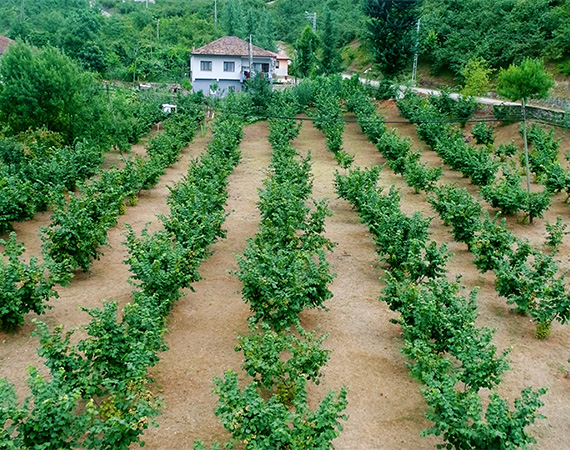
Turkey's April Frost Devastates Hazelnut Crops and Drives Global Prices Up 34 Percent in August
When Spring Turned to Winter: Turkey's Hazelnut Crisis Reshapes Global Markets
The Black Sea's agricultural heartland faces its worst frost disaster in decades, sending shockwaves through global confectionery supply chains and investor portfolios
TRABZON, Turkey — When severe frost struck Turkey's hazelnut-producing regions during a critical four-day period in April, the immediate damage was apparent to agricultural officials. What has emerged in the months since reveals a market disruption of unprecedented scale.

Wholesale hazelnut prices have surged 34% since the beginning of 2025, reaching €9,400 per ton—approximately $10,900—according to data from Netherlands-based commodity platform Vesper BV. The frost event, which Agriculture Minister İbrahim Yumaklı characterized as one of the worst agricultural disasters in the country's history, affected 36 provinces and devastated crops across Turkey's Black Sea coastal regions.
For a country that supplies roughly 70% of the world's hazelnuts, the April frost represents far more than regional agricultural damage. Market analysts describe a fundamental supply chain disruption with global implications extending from European confectionery manufacturers to institutional investment portfolios tracking agricultural commodities.
The global hazelnut market is highly concentrated because Turkey is the world's dominant producer. The country's preeminence is largely due to its ideal climate conditions, as hazelnuts require a specific environment that is not widely available globally.
The Frost That Changed Everything
The meteorological event that triggered this crisis unfolded with devastating precision between April 9-13, 2025. Temperatures plummeted to -15°C across 36 Turkish provinces, targeting the delicate hazelnut blossoms at their most vulnerable stage. Agriculture Minister İbrahim Yumaklı's characterization of the event as "one of the worst frost disasters in the country's agricultural history" understates neither the immediate devastation nor the long-term market implications.

Regional crop loss estimates vary dramatically—from 20% in higher-altitude areas with some natural protection to catastrophic losses exceeding 80% in the most exposed coastal regions of Ordu, Giresun, and Trabzon. These provinces form the backbone of Turkey's hazelnut industry, accounting for the majority of global production outside of what food industry analysts describe as limited and inconsistent alternative sources.
Wholesale hazelnut prices have surged dramatically in 2025 following the April frost event in Turkey.
| Year/Month | Region/Type | Price (per ton) |
|---|---|---|
| March 2025 | Turkey (Export) | $4,163 |
| 2024 | European Union (Export) | $4,456 |
| 2014 | European Union (Peak Export) | $5,153 |
Market intelligence suggests the Turkish State Marketing Organization's (TMO) hazelnut reserves, already depleted to roughly 85,000 tons from previous seasons, cannot buffer the supply shortage. Industry sources indicate panic buying and strategic withholding by producers anticipating further price increases have exacerbated market tightness beyond what fundamental supply-demand metrics alone would suggest.
Ripple Effects Across Global Supply Chains
The implications extend far beyond Turkey's borders. European confectionery manufacturers, particularly those producing hazelnut-intensive products, face an unprecedented input cost crisis. Anonymous industry executives describe scenarios where established product formulations may require fundamental reformulation to remain economically viable.

The timing amplifies the crisis. Global confectionery production typically begins ingredient procurement for holiday season production during late summer and early autumn. With Turkish hazelnut availability constrained and prices elevated, manufacturers confront difficult choices between absorbing dramatic cost increases or passing them through to consumers already sensitive to broader food inflation.
Alternative sourcing presents limited relief. Georgia's hazelnut production, while growing, represents roughly 2% of global output. Chilean and American production, while quality-consistent, cannot scale to replace Turkish volumes. Investment analysts tracking agricultural commodity markets note that no combination of alternative sources can meaningfully offset Turkey's reduced production within the current crop year.
Market Structure Under Stress
The hazelnut market's concentration creates particular vulnerability to supply disruptions. Unlike more geographically diversified commodities, Turkey's dominance means that regional weather events translate directly into global price volatility. The current crisis recalls the 2014 frost event, though early analysis suggests 2025's impact may prove more severe and prolonged.
(Table showing global hazelnut production by country, highlighting Turkey’s overwhelming share and the vulnerability of global supply to regional events.)
| Rank | Country | Production (tonnes, 2023) | Global Share (%) |
|---|---|---|---|
| 1 | Turkey | 1,130,000 | ~58–70% |
| 2 | Italy | 84,670 – 102,740 | ~7–9% |
| 3 | Azerbaijan | 75,409 | ~6–7% |
| 4 | Chile | 65,647 | ~5–6% |
| 5 | Georgia | 36,900 | ~3% |
| 6 | China | ~25,000 | ~2% |
| 7 | France | ~20,000 | ~2% |
| 8 | Iran | ~15,000 | ~1% |
| 9 | Poland | ~12,000 | ~1% |
| — | Others | ~35,000 | ~3% |
| — | World Total | 1,100,000 – 1,130,000 | 100% |
Currency dynamics compound the situation. While a weaker Turkish lira might typically provide some pricing relief for international buyers, the TMO's price floor mechanisms—setting purchase prices at TRY 195-200 per kilogram—establish a sturdy foundation under domestic pricing that limits downside flexibility for exporters.
Trading house sources describe a market structure approaching dysfunction, with traditional price discovery mechanisms strained by information asymmetries and strategic behavior among market participants. Some exporters reportedly hold inventory off-market, anticipating further price appreciation, while major industrial users face procurement challenges that extend beyond simple price sensitivity.
Investment Implications and Portfolio Positioning
For sophisticated investors, Turkey's hazelnut crisis presents both risks and opportunities requiring nuanced positioning. European confectionery companies face a complex calculus where pricing power varies significantly by market segment and product category.
Premium chocolate manufacturers with strong brand loyalty may navigate input cost inflation more successfully than mass-market producers competing primarily on price. However, the dual pressures of elevated cocoa prices—already stressing confectionery margins—combined with hazelnut cost inflation create what several investment analysts describe as a potentially severe margin compression scenario.
Margin compression is the reduction of a company's profit margins over time. It typically occurs when rising input costs, such as labor or materials, outpace a company's ability to increase its prices, squeezing overall profitability.
Equity research suggests viewing exposure through a differentiated lens. Companies with diversified ingredient portfolios and flexible formulation capabilities may outperform those heavily dependent on hazelnut-intensive products. Industrial food processors with strong customer relationships and pass-through pricing mechanisms could weather the crisis more effectively than branded consumer goods companies bearing direct margin pressure.
Climate Reality and Agricultural Vulnerability
Beyond immediate market dynamics, Turkey's hazelnut crisis illuminates broader themes around climate volatility and agricultural security. Meteorological data indicates increasing frequency and severity of extreme weather events across major agricultural regions, suggesting that the 2025 frost may represent not an anomaly but a preview of systemic vulnerability.
Agricultural economists point to growing evidence that traditional risk management approaches—based on historical weather patterns and seasonal predictability—may prove inadequate for addressing climate change's accelerating impact on crop production. Turkey's experience demonstrates how quickly regional weather events can cascade into global market disruption.
The country's agricultural sector, already managing currency volatility and structural challenges, now confronts the reality that climate variability represents an escalating threat to economic stability. Investment in climate-resilient agricultural practices and crop diversification becomes not merely environmental policy but economic necessity.
Navigating Uncertainty Ahead
Market analysts project continued price volatility through the remainder of 2025 and into the 2026 growing season. Base-case scenarios anticipate hazelnut prices maintaining elevated levels—potentially in the €9,500-€11,000 per ton range—with upside risk extending considerably higher should secondary weather events or pest pressures further constrain usable crop output.
Forward-looking investors may consider several positioning strategies. Direct commodity exposure remains challenging given limited liquid futures markets for hazelnuts, but cross-hedge opportunities exist through currency markets and broader agricultural commodity baskets. Equity positioning requires careful attention to individual company exposure profiles rather than broad sector allocation.
For institutional portfolios, Turkey's hazelnut crisis underscores the increasing importance of climate risk assessment in agricultural investment analysis. Traditional financial modeling approaches may underestimate the frequency and severity of weather-related supply disruptions, suggesting the need for more sophisticated risk management frameworks.
The unfolding crisis serves as a reminder that in an interconnected global economy, regional weather events can rapidly evolve into systemic market disruptions. As climate volatility increases, investors across asset classes must prepare for a world where agricultural supply shocks become not exceptional events but recurring challenges requiring adaptive strategies and sophisticated risk management.
For now, the silence in Turkey's hazelnut groves speaks to a market transformation whose full implications remain to unfold—a stark reminder that in commodity markets, nature still holds the final word.
This analysis is based on current market data and established economic indicators. Past performance does not guarantee future results. Readers should consult qualified financial advisors for personalized investment guidance.